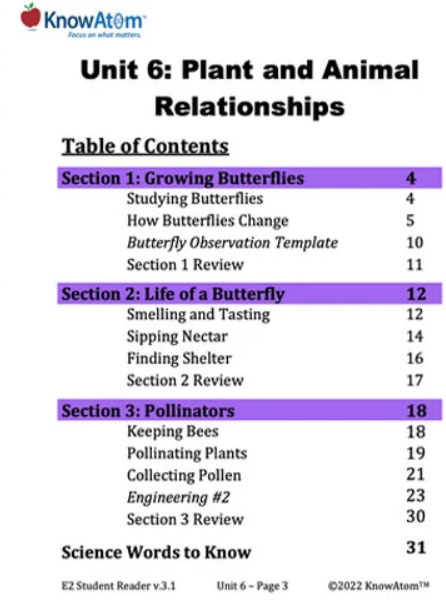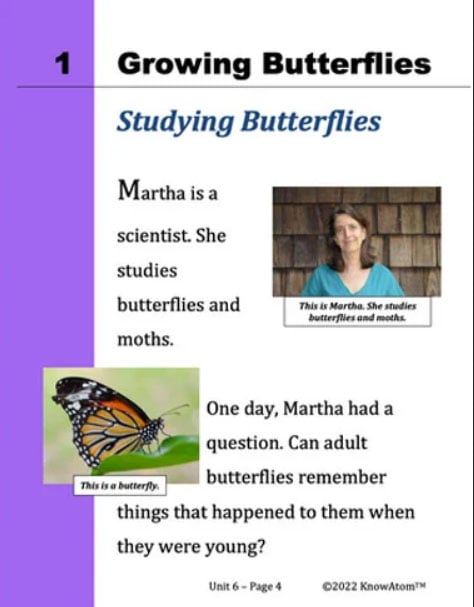Students begin this unit by focusing on how butterflies undergo metamorphosis as they move through their life cycle. Students observe the different stages of painted lady butterflies as they develop and grow.
In the last unit, students investigated whether plants need light and water to grow, and then explored how flowers have specific structures that help them attract pollinators to make seeds. In this unit, students focus on one kind of pollinator—the butterfly. They observe butterflies moving through their life cycle and then create a model butterfly to observe its different parts. This page showcases all of the essential parts of the first lesson in this unit.
Science background gives teachers in-depth information on the phenomena being studied in this unit. It helps teachers facilitate Socratic dialogues with students surrounding the topic being explored which in this case, is the butterfly life cycle.
Weiss was curious about the memory of butterflies and moths because they undergo a complete metamorphosis. Metamorphosis happens when a living thing completely changes its form from one stage to the next in its life cycle. A life cycle is the stages a living thing goes through on its way from birth to death.
The life cycle of a butterfly includes four stages. In the first stage, an adult female lays tiny, round eggs scattered or clustered together on a host plant that will later become food for her offspring. Every type of butterfly or moth egg takes a different amount of time to hatch.
When the eggs hatch, larvae emerge. The larva is an insect’s young, worm-like form. The larvae of butterflies and moths are caterpillars. The caterpillar exists to eat, only taking breaks to defecate or shed its skin (molt) and grow larger.
When the caterpillar finishes growing, it encloses itself in a protective skin (called a chrysalis for butterflies) and becomes a pupa. The pupa is the inactive stage of an insect when it doesn’t eat, but inside, the entire structure of the caterpillar is changing. Its organs are breaking down, and it is re-forming into a butterfly or moth.
Students begin this unit by focusing on how butterflies undergo metamorphosis as they move through their life cycle. Students observe the different stages of painted lady butterflies as they develop and grow.

Prepared hands-on materials, full year grade-specific curriculum, and personalized live professional development designed to support mastery of current state science standards.
Abdomen: the back segment of an insect where the stomach is
Antennae: body parts of insects that are used to smell, touch, and taste things
Larva: an insect’s young, worm-like form; a caterpillar for butterflies and moths
Pupa: the inactive stage of an insect when it changes; does not eat
Head: the front segment of an insect where the antennae, mouthparts, and eyes are found
Life cycle: the stages an organism passes through on its way from birth to death
Metamorphosis: when a living thing completely changes its form from one stage to the next in its life cycle
Thorax: the middle segment of an insect where the legs and wings are found
Studying Butterflies
Martha is a scientist. She studies butterflies and moths. One day, Martha had a question. Can adult butterflies remember things that happened to them when they were young?
How Butterflies Change
Butterflies and moths don’t grow like people do. As you grow, you get bigger. But your body keeps the same parts. Your head looks similar. So do your arms and legs.
Butterflies and moths go through a complete change as they grow. A young butterfly doesn’t look like an adult butterfly. This is why Martha was curious. She wanted to know if butterflies and moths remember things after they change.
As living things grow, they move through a life cycle. A life cycle is the stages all living things go through on their way from birth to death.
Butterflies and moths start as eggs. This is stage one. Time passes.
The eggs hatch. A caterpillar comes out of the egg. This caterpillar is the larva of moths and butterflies. A larva is an insect’s young, worm-like form. This is stage two.
Caterpillars eat a lot. They need to grow big. When a caterpillar grows big enough, it covers itself with a skin to protect it. It hangs from a branch. It is now in stage three. It is a pupa. The pupa is inactive. It doesn’t eat. It survives on the food it stored as a caterpillar. This is a pupa.
From the outside, it doesn’t look like much is happening. But inside, all of the parts of the caterpillar are changing. It is becoming a butterfly.



In this lesson, students observe the butterfly life cycle and create a diagram of the painted lady butterfly at each state in its life cycle to gather data on how it changes as it moves from birth to death. Students use their magnifying glasses to observe the painted lady caterpillars as they progress through each stage of their life cycle. Students use information from the student reader and their own observations to evaluate what butterflies need to survive—such as air, water, and food—and how butterflies are different from plants.
KnowAtom incorporates formative and summative assessments designed to make students thinking visible for deeper student-centered learning.

Standards citation: NGSS Lead States. 2013. Next Generation Science Standards: For States, By States. Washington, DC: The National Academies Press. Neither WestEd nor the lead states and partners that developed the Next Generation Science Standards were involved in the production of this product, and do not endorse it.
